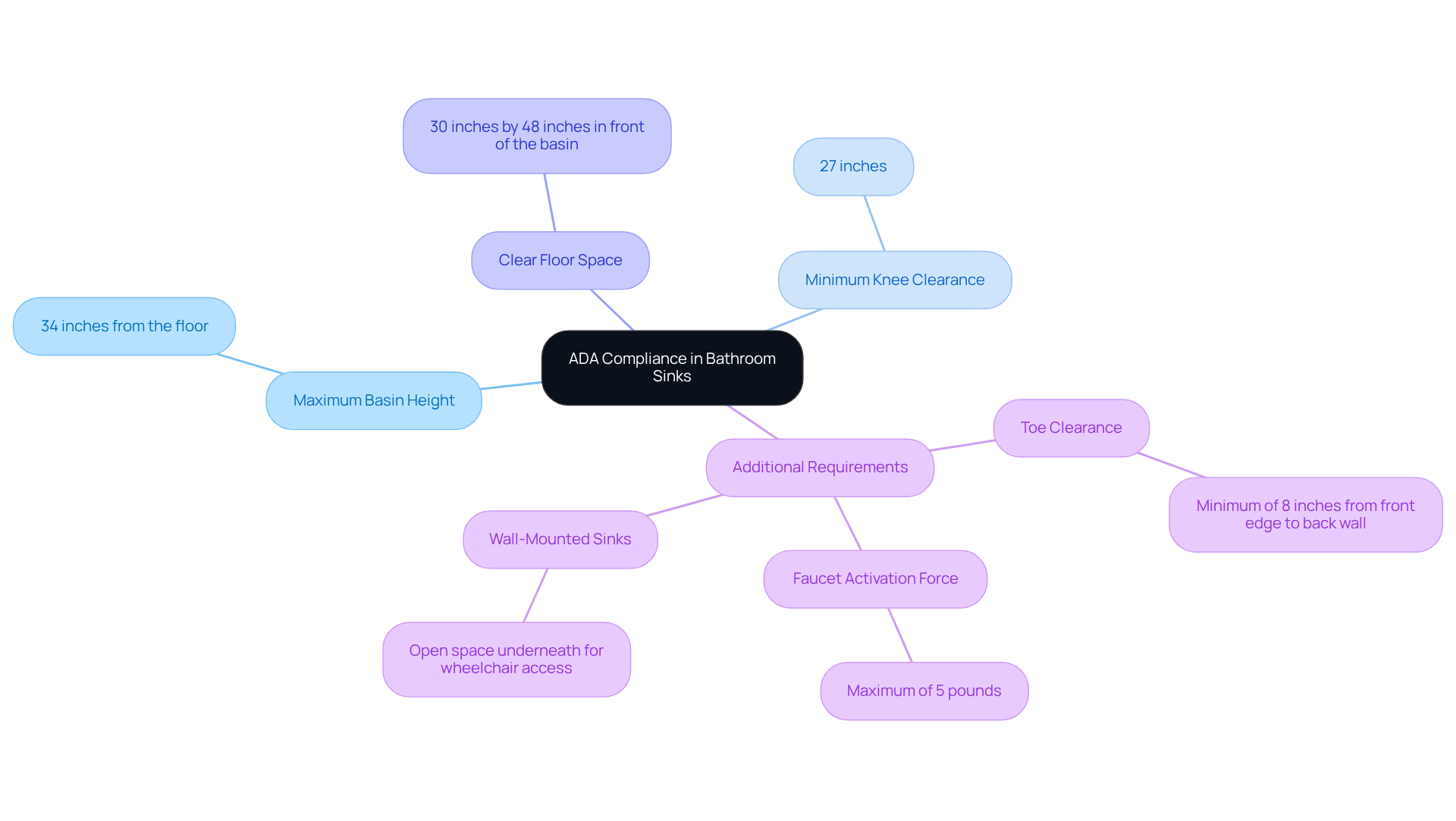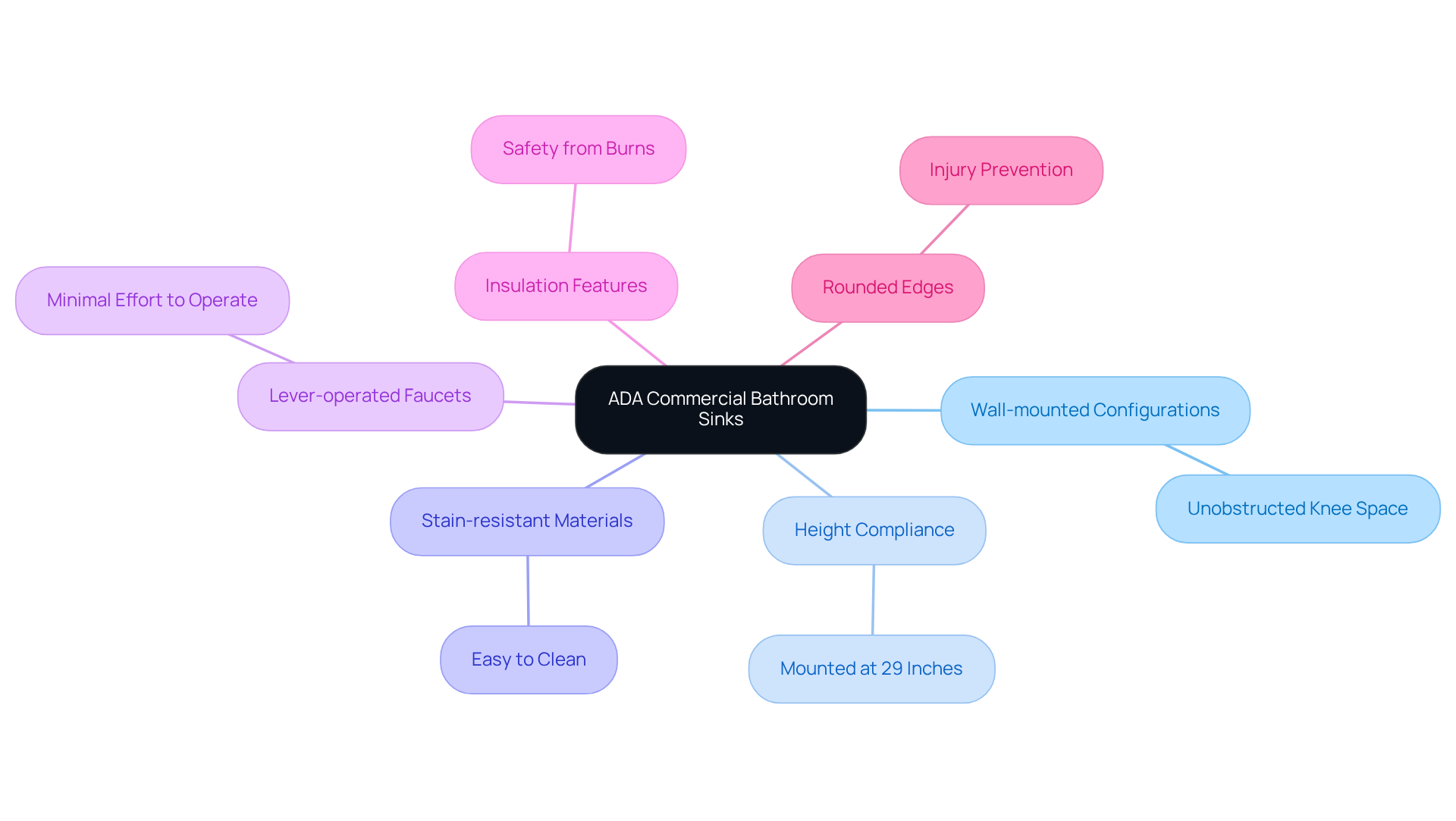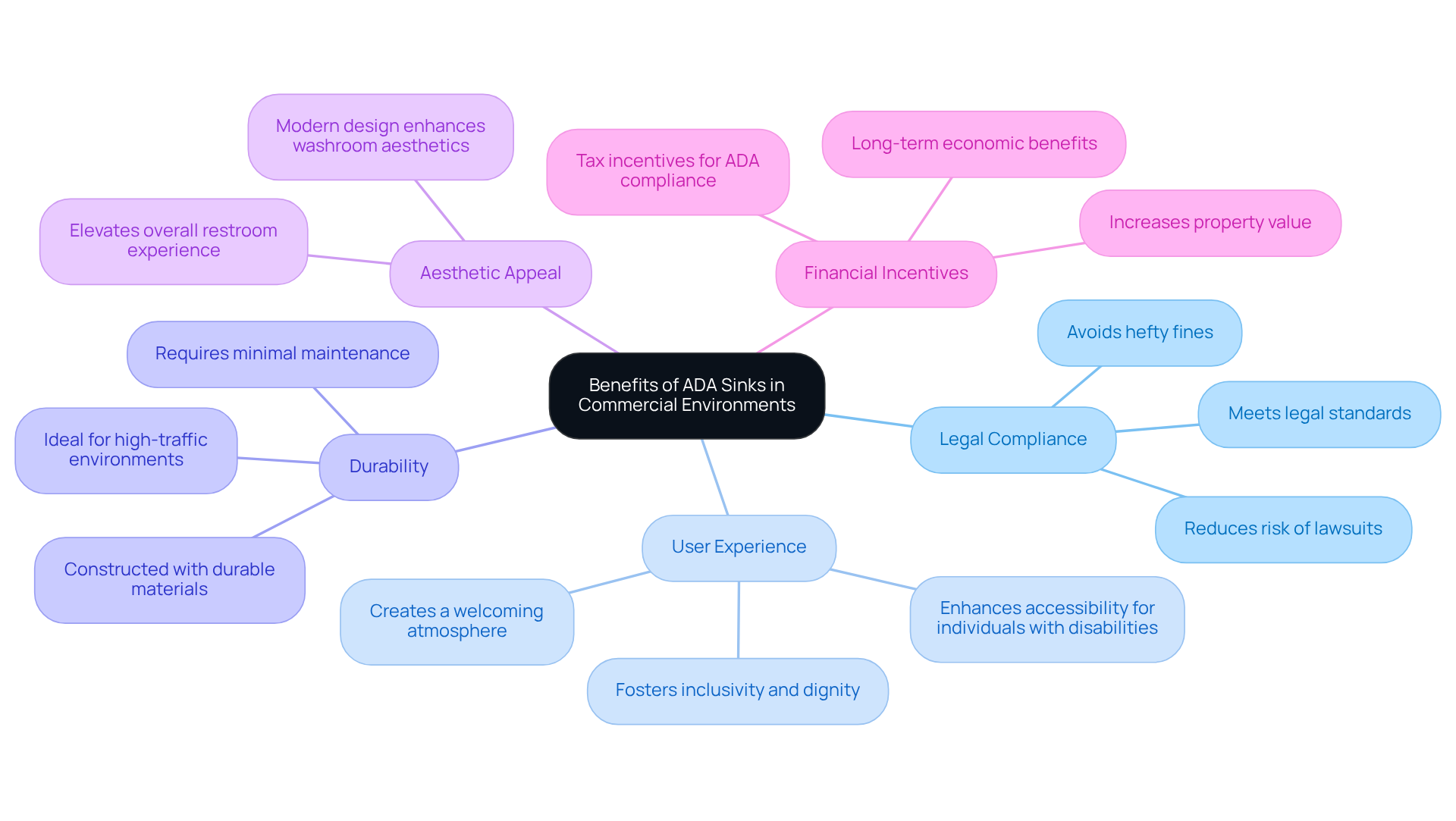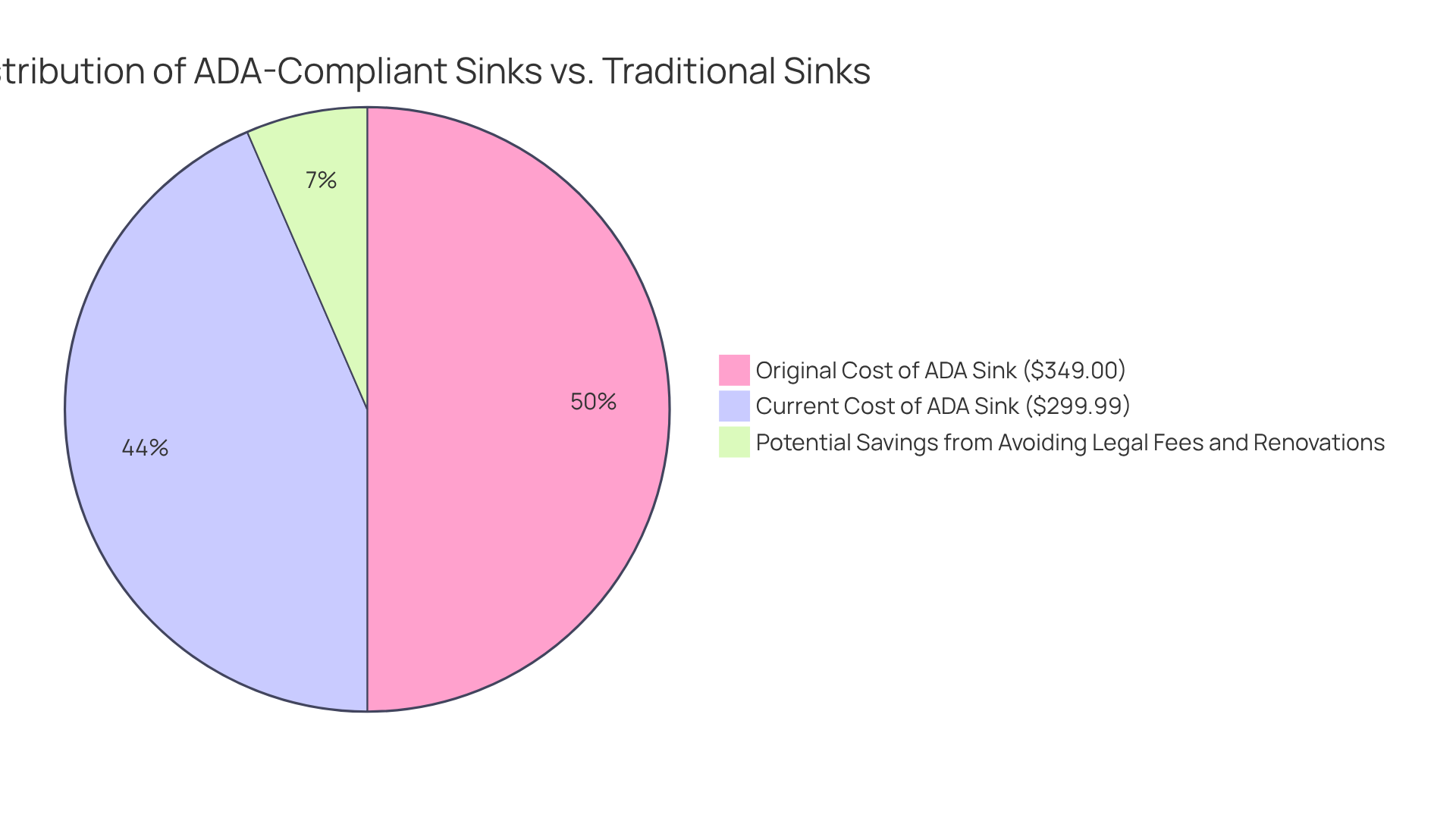Overview
This article provides a comprehensive comparison of ADA commercial bathroom sinks and traditional options, emphasizing the superior accessibility features and long-term benefits associated with ADA-compliant sinks. While it is acknowledged that ADA sinks may incur a higher initial cost, the article articulates that they offer substantial advantages in terms of legal compliance, user satisfaction, and potential long-term savings. These factors collectively position ADA sinks as a more prudent investment for commercial environments, ultimately reinforcing the notion that prioritizing accessibility is not only a legal obligation but also a strategic business decision.
Introduction
The push for inclusivity in public spaces has never been more vital, especially regarding essential facilities like restrooms. ADA commercial bathroom sinks are at the forefront of this movement. They are designed not only to meet legal standards but also to enhance the user experience for individuals with disabilities. As businesses grapple with the challenges of compliance, they must consider whether the investment in ADA-compliant fixtures outweighs the costs associated with traditional options. How do these specialized sinks transform public restrooms from mere necessities into welcoming environments for all?
Understanding ADA Compliance in Bathroom Sinks
ADA compliance in ADA commercial bathroom sinks is a critical aspect governed by the Americans with Disabilities Act (ADA), mandating that public facilities must ensure accessibility for individuals with disabilities. The key requirements include:
- A maximum basin height of 34 inches from the floor
- A minimum knee clearance of 27 inches
- A clear floor space of at least 30 inches by 48 inches in front of the basin, facilitating wheelchair maneuverability
These specifications are designed to ensure that wheelchair users can approach and utilize the basin with ease. Furthermore, the basin must be constructed to allow for a forward approach, which is essential for accessibility. Understanding these regulations is vital for guaranteeing that facility designs are not only compliant but also functional and user-friendly for all individuals, regardless of their physical abilities.
Architects assert that thoughtful design can significantly enhance usability while maintaining aesthetic appeal. Successful implementations of ADA commercial bathroom sinks in public facilities exemplify this principle, with notable projects such as those at Padel Haus and Lacuna Space demonstrating how adherence to ADA guidelines can lead to well-designed restrooms that accommodate diverse user needs. As the ADA continues to evolve, it is imperative for architects and designers to stay informed about the latest requirements, ensuring they create inclusive environments.

Key Features of ADA Commercial Bathroom Sinks
ADA commercial bathroom sinks are meticulously designed to enhance accessibility and usability.
- Featuring wall-mounted configurations, these basins provide unobstructed knee space, allowing wheelchair users to approach comfortably.
- Installed at a height of 29 inches, they ensure adherence to ADA standards while fostering inclusivity.
- The materials used are often stain-resistant and easy to clean, essential for maintaining hygiene in high-traffic environments.
- Furthermore, innovations in ADA fixture design include lever-operated faucets that require minimal effort to operate, catering to individuals with limited hand strength.
- Insulation on ADA basins prevents the outer surface from becoming too hot, decreasing the risk of burns for users.
- Rounded edges are incorporated into the design to prevent injuries, enhancing safety for all users.
These considerate attributes not only guarantee adherence to regulations but also greatly enhance the overall bathroom experience, making ADA commercial bathroom sinks a favored option in contemporary commercial environments.
In addition, the setup of ADA-compliant basins assists businesses in conforming to legal obligations, preventing possible expenses linked to modifying non-compliant restrooms. By prioritizing accessibility, these fixtures encourage inclusivity, ensuring restroom access for all, regardless of their abilities.

Benefits of ADA Sinks in Commercial Environments
The installation of ADA commercial bathroom sinks in commercial settings presents a multitude of benefits. Primarily, these basins ensure compliance with legal standards, significantly diminishing the risk of lawsuits and fines associated with non-compliance. Statistics indicate that nearly 73% of establishments do not meet ADA compliance standards, underscoring the urgent need for businesses to prioritize accessibility. Moreover, the installation of ADA commercial bathroom sinks enhances the user experience by providing accessible facilities for individuals with disabilities, thereby fostering inclusivity and dignity. Facility managers have observed that the presence of ADA commercial bathroom sinks not only fulfills legal obligations but also cultivates a welcoming atmosphere for all patrons. As one facility manager articulated, "The incorporation of ADA fixtures has transformed our washrooms into spaces that everyone can utilize comfortably, reflecting our commitment to inclusivity." This sentiment is echoed by architects like Brent Otsuka from Fentress Architects, who emphasizes that The Splash Lab's exquisitely designed products are essential for creating holistically designed lavatories.
In addition to legal adherence and user satisfaction, ADA commercial bathroom sinks are often constructed with durable materials that require minimal maintenance, leading to long-term financial savings. This durability is particularly advantageous in high-traffic environments where wear and tear can be substantial. Furthermore, the modern aesthetic of ADA commercial bathroom sinks can elevate the overall design of a washroom, making it more inviting and appealing to all users. The increasing demand for accessible spaces, particularly as the population ages, further highlights the necessity of incorporating ADA commercial bathroom sinks. Case studies reveal that the integration of ADA-compliant fixtures enhances both functionality and design, ultimately resulting in a favorable bathroom experience.
This combination of legal compliance, enhanced user satisfaction, and visual appeal positions ADA commercial bathroom sinks as a prudent choice for any restroom, ensuring that facilities are not only accessible but also aesthetically pleasing. Additionally, companies can benefit financially from ADA compliance through accessible tax incentives, further augmenting the investment in ADA solutions.

Cost Considerations: ADA Sinks vs. Traditional Sinks
When assessing the expenses related to ADA commercial bathroom sinks compared to conventional basins, several key elements must be considered. In 2025, ADA-compliant basins are priced at $299.99, down from the original cost of $349.00, reflecting changes in design and materials. While this price may appear elevated relative to some conventional basins, the long-term financial benefits often outweigh the initial expenses. Conventional basins may offer lower upfront costs, yet they can lead to significant expenses associated with potential legal fees, necessary renovations for compliance, and ongoing maintenance.
Furthermore, installing ADA-compliant basins not only ensures legal compliance—thus averting potential fines or legal actions—but also enhances a facility's image by showcasing a commitment to accessibility. This dedication can attract a broader customer base and contribute to increased property value and usability. Additionally, factors influencing plumbing costs, such as the type of building, whether it is a retrofit or new construction, and local plumbing codes, should be accounted for when budgeting for these installations. For instance, projects like Padel Haus in New York and Lacuna Space in California illustrate how The Splash Lab's customized sanitation solutions effectively address various industry requirements while promoting inclusivity.
In summary, while the initial investment in ADA commercial bathroom sinks may be higher, the overall value they provide—through compliance, user satisfaction, and long-term savings—makes them a prudent choice for commercial restroom environments.

Conclusion
ADA commercial bathroom sinks signify a pivotal advancement in promoting accessibility within public facilities. By aligning with the Americans with Disabilities Act (ADA) guidelines, these sinks not only fulfill legal obligations but also significantly improve restroom usability for individuals with disabilities. The meticulous design of ADA sinks—featuring appropriate height, knee clearance, and user-friendly materials—highlights the critical importance of cultivating inclusive environments that serve all users.
This article underscores several vital aspects of ADA commercial bathroom sinks, including:
- Their adherence to ADA specifications
- The advantages they present in commercial contexts
- The financial considerations when juxtaposed with traditional sinks
Importantly, the incorporation of ADA sinks cultivates a welcoming atmosphere, mitigates the risk of legal disputes, and elevates user satisfaction. Additionally, the long-term economic benefits, such as lower maintenance costs and potential tax incentives, position ADA-compliant sinks as a prudent investment for any enterprise.
Ultimately, prioritizing the installation of ADA commercial bathroom sinks transcends mere compliance; it embodies a steadfast commitment to inclusivity and accessibility. As the demand for accessible facilities escalates, businesses are urged to adopt these solutions, ensuring that every individual can experience dignified and functional restroom access. Investing in ADA-compliant designs not only enhances a facility's reputation but also fosters a more equitable society, where everyone can comfortably access essential services.
Frequently Asked Questions
What is ADA compliance in bathroom sinks?
ADA compliance in bathroom sinks refers to the adherence to the Americans with Disabilities Act (ADA) requirements that ensure accessibility for individuals with disabilities in public facilities.
What are the key requirements for ADA-compliant bathroom sinks?
The key requirements include a maximum basin height of 34 inches from the floor, a minimum knee clearance of 27 inches, and a clear floor space of at least 30 inches by 48 inches in front of the basin to facilitate wheelchair maneuverability.
Why is knee clearance important in ADA-compliant sinks?
Knee clearance is important because it allows wheelchair users to approach and utilize the sink comfortably and safely.
How should the basin be constructed for ADA compliance?
The basin must be constructed to allow for a forward approach, which is essential for accessibility.
What is the significance of thoughtful design in ADA compliance?
Thoughtful design enhances usability while maintaining aesthetic appeal, ensuring that facilities are both compliant and functional for all individuals.
Can you provide examples of successful ADA-compliant bathroom sink implementations?
Notable projects such as those at Padel Haus and Lacuna Space demonstrate how adherence to ADA guidelines can lead to well-designed restrooms that accommodate diverse user needs.
Why is it important for architects and designers to stay informed about ADA requirements?
It is important for architects and designers to stay informed about the latest ADA requirements to ensure they create inclusive environments that meet the needs of all users.




